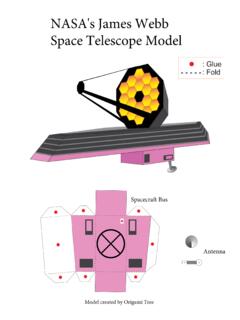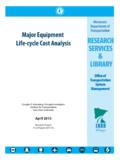Transcription of Activity: Life Cycle of a Massive Star - NASA
1 activity : life Cycle of a Massive star Objective: The NASA/James Webb Space Telescope life Cycle bookmark will model the life Cycle of a Massive star using beads to represent a star s development. The James Webb Space Telescope and star Formation: The James Webb Space Telescope (Webb) will launch in 2021 and will see light in the infrared part of the spectrum. Spanning the size of a tennis court and standing three stories tall, Webb will be the largest observatory ever sent into space. From its orbit some one and a half million kilometers away from Earth about four times the Earth-Moon distance Webb will be used to study many things, including the life cycles of stars. Within this activity , students will make a visual representation of the life Cycle of a Massive star by associating different colored pony beads to different stages of stellar life .
2 Materials: - Pony Beads: green, blue, white, yellow, orange, red, black, & green - Cord or yarn - Tape - Scissors - Webb life Cycle bookmark (If available, use heavy-card-stock paper for bookmark) Procedure: 1) Ask student to describe a life Cycle that is familiar to them. Help facilitate this conversation by using a guided approach . Then discuss that a star also goes through a life Cycle . 2) Discuss that a star s life Cycle depends on its mass. Review that Webb will help us study the life Cycle of stars (See resource below). 3) To begin activity , cut six to eight inches of yarn and tie it to the end of the stellar life Cycle bookmark. 4) Tape the end of the cord/yarn for easy threading of the beads. Have students model the correct order of beads by color by referring to their bookmark.
3 Check for correct order before tying a final knot. life Cycle of a Massive star : Step 1 - Green - A cloud of gas and dust collapses due to gravity, creating a protostar. Step 2 - Blue - Gravitational energy powers the young star Step 3 - Yellow - ..nuclear fusion occurs. The main sequence star may live millions or even billions of years. Step 4 - Red - The star expands into a red giant when the star 's hydrogen level drops. Step 5 - Orange - Different fusion processes occur. The star expands, cools, and loses mass each time. Step 6 - White - Fusion stops and a supernova explosion occurs. Most of the star is blown away. Step 7 - Black - Depending on the original star s mass, either a black hole or neutron star remains. Step 8 - Green - The material shed during the star 's life joins new gas clouds, and new stars are formed.
4 Resources: NASA: James Webb Space Telescope NASA: Imagine the Universe The life Cycles of Stars





